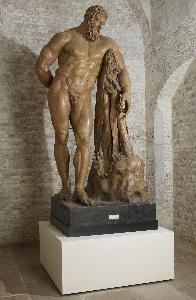Glycon The Athenian
Glycon The Athenian;Lysippus
Place: Sicyon
Biography:
Lysippus (Greek: Λυσίππος, Lysíppos; c. 395 – c. 305 BC) was a Greek sculptor from Sicyon, the son of Lysistratus and grandson of the sculptor Botheas. He was the most celebrated of the ancient Greek sculptors of the fourth century BC, and was said to have made over 1500 statues, of which many survive in Roman copies. He was the teacher of Chares of Lindos and of Harmodius and Athenodorus of Chios. He was the first to represent the nude body in motion, and was the first to attain a high degree of naturalism in the rendering of the human form. He was also the first to introduce the contrapposto pose, in which the figure is twisted and the weight is distributed unevenly, giving a more dynamic and lifelike appearance. He was also known for his skill in portraiture, and was said to have made portraits of Alexander the Great and of the philosopher Socrates. He was also known for his skill in casting bronze statues, and was said to have invented a new method of casting in which the statue was cast in several pieces and then assembled. He was also known for his skill in working with marble, and was said to have made a statue of the god Apollo in marble that was so lifelike that it was said to have spoken. He was also known for his skill in working with gold and silver, and was said to have made a statue of the goddess Athena in gold and silver that was so beautiful that it was said to have been the most beautiful statue in the world. He was also known for his skill in working with ivory, and was said to have made a statue of the goddess Aphrodite in ivory that was so beautiful that it was said to have been the most beautiful statue in the world. He was also known for his skill in working with precious stones, and was said to have made a statue of the goddess Aphrodite in precious stones that was so beautiful that it was said to have been the most beautiful statue in the world. He was also known for his skill in working with enamel, and was said to have made a statue of the goddess Aphrodite in enamel that was so beautiful that it was said to have been the most beautiful statue in the world. He was also known for his skill in working with glass, and was said to have made a statue of the goddess Aphrodite in glass that was so beautiful that it was said to have been the most beautiful statue in the world. He was also known for his skill in working with crystal, and was said to have made a statue of the goddess Aphrodite in crystal that was so beautiful that it was said to have been the most beautiful statue in the world. He was also known for his skill in working with amber, and was said to have made a statue of the goddess Aphrodite in amber that was so beautiful that it was said to have been the most beautiful statue in the world. He was also known for his skill in working with coral, and was said to have made a statue of the goddess Aphrodite in coral that was so beautiful that it was said to have been the most beautiful statue in the world. He was also known for his skill in working with pearls, and was said to have made a statue of the goddess Aphrodite in pearls that was so beautiful that it was said to have been the most beautiful statue in the world. He was also known for his skill in working with shells, and was said to have made a statue of the goddess Aphrodite in shells that was so beautiful that it was said to have been the most beautiful statue in the world. He was also known for his skill in working with wood, and was said to have made a statue of the goddess Aphrodite in wood that was so beautiful that it was said to have been the most beautiful statue in the world. He was also known for his skill in working with metal, and was said to have made a statue of the goddess

